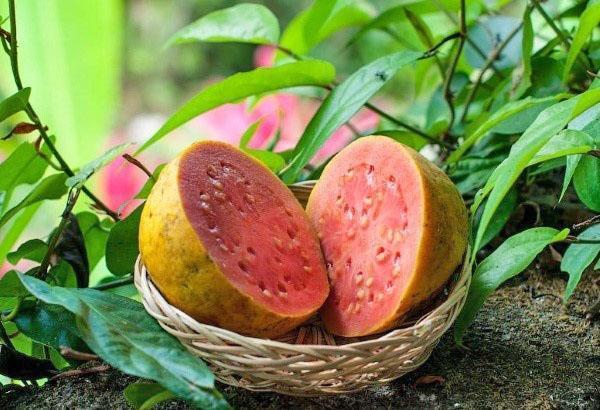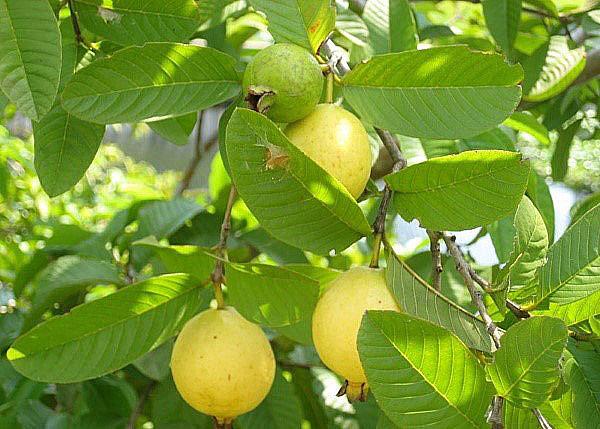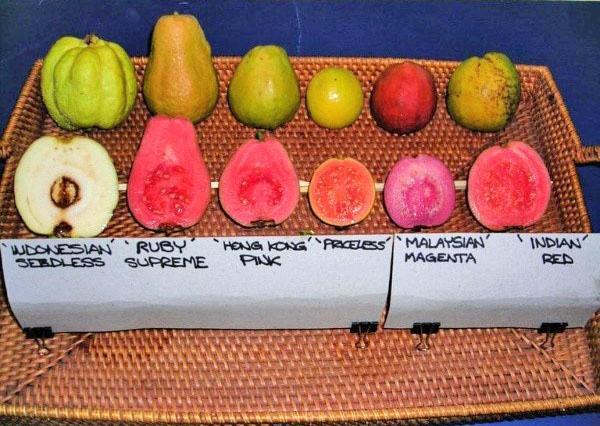Introducing a tropical apple or exotic guava fruit
 The tropical apple came to us from distant Mexico and America, in addition, it took root well in other countries, especially in India and Africa. What is this miracle, the guava fruit? Let's get to know him better, because some exotic lovers have managed to grow a foreigner even at home, and for this it is worth knowing at least a little about what the culture is and what requirements it has.
The tropical apple came to us from distant Mexico and America, in addition, it took root well in other countries, especially in India and Africa. What is this miracle, the guava fruit? Let's get to know him better, because some exotic lovers have managed to grow a foreigner even at home, and for this it is worth knowing at least a little about what the culture is and what requirements it has.
The scientific name of the plant is no less exotic and sounds like "psidium".
Botanical characteristic

Guava leaves do not fall even in winter. Five months after flowering (sometimes three), large fruits weighing up to 160 g ripen on the tree. By the way, the flowering bush looks very impressive with its white inflorescences. The tree bears fruit quite richly: up to 100 kg of fruit can be harvested from one crop. There is also a second wave of fruiting, but in this case, the size of fruits and their number is half.
Taste qualities of exotic
 Guava looks like a cross between an apple, lemon and a pear. The fruits are rounded, like an apple, or slightly elongated, like a pear. The dense bumpy skin resembles citrus fruits, but in yellow fruits it looks more like a quince.
Guava looks like a cross between an apple, lemon and a pear. The fruits are rounded, like an apple, or slightly elongated, like a pear. The dense bumpy skin resembles citrus fruits, but in yellow fruits it looks more like a quince.
As the fruit ripens, they turn yellow or burgundy, but some species remain green. Ripe fruits spread a strong lemon scent around them.
The thicker the peel of the guava, the more bitter it is; the sweetest fruits are those with a thin skin.
The flesh of the fruit is quite dense and juicy; small hard seeds of yellow color are hidden inside. There are a lot of them, more than 100 pieces in one fruit, covered with a hard shell on top, and therefore some difficulties arise when growing guava by seed method.
To have an idea of what the fruits look like, we suggest that you familiarize yourself with the photo of guava fruits:



It is very difficult to answer unequivocally what the taste of guava is like. It depends on the specific variety. Most species have white pulp, but there are varieties in which it is pinkish, yellow and even red. For example, varieties with red fruits are more like raspberries, while their skin has a coniferous flavor. But strawberry guava, respectively, tastes strawberries with a light pineapple aftertaste. But regardless of the variety, ripe psidium is very sweet. Unripe fruits are sour, and they are not recommended to be consumed.
Green fruits can not only cause digestive upset, but also have a negative effect on kidney function.
How is guava eaten? The answer is unambiguous - only fresh. Long-term storage of fruits only worsens their taste, but they can still lie down in the refrigerator for a day or two, but the freezer is a completely different matter. The only condition: the presence of a sealed package, since the fruit quickly absorbs odors.
 Fresh fruits can be made from ripe fruits - it is also very tasty and sweet.Fresh or frozen fruits are added to or prepared from various dishes jelly and syrups, and from the dried fruits the original oriental cheese is obtained. Still juicy pulp can be marinated, and you get an original side dish for meat.
Fresh fruits can be made from ripe fruits - it is also very tasty and sweet.Fresh or frozen fruits are added to or prepared from various dishes jelly and syrups, and from the dried fruits the original oriental cheese is obtained. Still juicy pulp can be marinated, and you get an original side dish for meat.
 And a little more about eating whole fruits, namely, how to eat guava correctly. This is best done by cutting it into wedges. It is advisable to eat them along with the skins and seeds for maximum benefit. At the same time, one should not forget that the peel can be bitter or with a coniferous taste (then it is better to cut it off), and the seeds have a hard shell. Therefore, we eat carefully, swallowing them whole, and you can gnaw them if you are sure of the strength of your teeth.
And a little more about eating whole fruits, namely, how to eat guava correctly. This is best done by cutting it into wedges. It is advisable to eat them along with the skins and seeds for maximum benefit. At the same time, one should not forget that the peel can be bitter or with a coniferous taste (then it is better to cut it off), and the seeds have a hard shell. Therefore, we eat carefully, swallowing them whole, and you can gnaw them if you are sure of the strength of your teeth.
Not a fruit, but a vitamin bomb
 Guava fruits, despite their sweetness, contain only 69 kcal, but they contain more than enough vitamins and microelements. Among them:
Guava fruits, despite their sweetness, contain only 69 kcal, but they contain more than enough vitamins and microelements. Among them:
- iron;
- calcium;
- phosphorus;
- magnesium;
- sodium;
- potassium;
- vitamin of group B, A, C and PP.
As in other fruits, guava contains the most water (80.7 g per 100 g of pulp), but there are only 17.4 carbohydrates, while the share of dietary fiber is 5.4 g.
What are the benefits of a tropical apple?
 Due to its rich complex of nutrients, psidium is recommended to be used for the prevention and treatment of many diseases, namely:
Due to its rich complex of nutrients, psidium is recommended to be used for the prevention and treatment of many diseases, namely:
- with gastrointestinal problems;
- for the treatment of inflammatory processes in the throat;
- with lung diseases;
- to relieve seizures and epileptic seizures;
- with heart disease.
The beneficial properties of guava fruit also relate to its peel: it contains antioxidants in an amount that exceeds their composition in the pulp of the fruit itself. Eating guava whole, together with the skin, helps relieve pain and spasms, helps relieve inflammation and acts as an antineoplastic agent in combination with the main therapy.
In addition to the juicy healthy pulp, leaves are also used for medicinal purposes. In folk medicine, decoctions of guava leaves are recommended to be taken for coughs, diseases of the oral cavity, dysentery. Herbal tea made from fresh leaves will help with frequent dizziness and will serve as an excellent tonic.
Can guava harm the body?
 There are no direct contraindications to the use of an exotic fruit, however, precautions should be observed even despite the beneficial properties of guava. First of all, this applies to persons susceptible to allergic reactions.
There are no direct contraindications to the use of an exotic fruit, however, precautions should be observed even despite the beneficial properties of guava. First of all, this applies to persons susceptible to allergic reactions.
With caution and in limited quantities, it is necessary to include guava in your diet for people with diabetes mellitus, because the use of sweet fruits, especially with the peel, causes a sharp jump in blood glucose.
You should not lean on juicy fruits even for absolutely healthy people - as you know, excess is not the norm, and eaten in large quantities can cause frustration, especially if the body tries them for the first time. The same effect will be after eating green fruits.
Is it possible to grow guava on your site?
 Recently, many exotic fruits have been found in local gardens, especially in the southern regions, where the warm climate is most consistent with their natural cultivation environment. However, growing guava at home in the open field is almost impossible in our country, since the tree will not stand the Russian winter. Critical for him are already 3 degrees of frost. This is enough for even an adult tree to die.
Recently, many exotic fruits have been found in local gardens, especially in the southern regions, where the warm climate is most consistent with their natural cultivation environment. However, growing guava at home in the open field is almost impossible in our country, since the tree will not stand the Russian winter. Critical for him are already 3 degrees of frost. This is enough for even an adult tree to die.
But do not despair, because there is another option - to grow guava as a pot culture, especially if there is a winter garden where it will be warm and light. Of course, the tree will hardly please with a bountiful harvest of 100 kg, as well as its large size, but it is still possible to enjoy ecologically clean fruits using self-pollinated varieties for this.
Unlike most plants, which often suffer from various diseases, guava has natural immunity and more rarely.This is a definite plus in her favor, as it minimizes the use of chemicals for tree treatment and ensures a safe and tasty harvest.
 As a houseplant, such a guava variety as the Littoral psidium, which is also coastal, is most suitable. Of the advantages of the variety, it is worth noting that it:
As a houseplant, such a guava variety as the Littoral psidium, which is also coastal, is most suitable. Of the advantages of the variety, it is worth noting that it:
- does not require pollination;
- resistant to diseases and pests;
- blooms beautifully with large white inflorescences;
- bears fruit in small (4 cm in diameter), but tasty, yellow fruit with a strong aroma;
- reproduces well both by seed and vegetative way.
 Slightly less fruit in the Catley variety (only 2 cm), but they taste like strawberries. This variety is also suitable for growing guava as a houseplant.
Slightly less fruit in the Catley variety (only 2 cm), but they taste like strawberries. This variety is also suitable for growing guava as a houseplant.
Growing features
 Some gardeners believe that seeds from fruits purchased for consumption in the domestic market or in a store are suitable material for its propagation. In some ways they are right, because they grow lemons and tangerines this way. But it is worth considering the fact that not all guava species are self-pollinated, there are also varieties among them that do not bear fruit without additional pollination, but this may already be a problem. It is best to purchase seed material in a special store - this way you will be sure that your tree will bear fruit, or use proven varieties.
Some gardeners believe that seeds from fruits purchased for consumption in the domestic market or in a store are suitable material for its propagation. In some ways they are right, because they grow lemons and tangerines this way. But it is worth considering the fact that not all guava species are self-pollinated, there are also varieties among them that do not bear fruit without additional pollination, but this may already be a problem. It is best to purchase seed material in a special store - this way you will be sure that your tree will bear fruit, or use proven varieties.
When planting, do not forget that the seeds have a hard shell. To speed up and facilitate germination, they must be soaked for 2-3 hours in a growth regulator. In addition, it does not hurt to scratch the seeds a little with sandpaper - this will make it easier for the sprout to hatch.
For growing seedlings, it is better to use a greenhouse or greenhouse, because they need a sufficiently high temperature, at least 24 degrees Celsius. It is not necessary to deepen the seeds, it is enough just to sow them on top of the loose soil and lightly sprinkle with sand. When the seedlings grow up and reach a height of about 5 cm, they must be pinched and transplanted into separate pots.
How to care for a home guava?
 Further care for the guava indoor fruit is simple and includes:
Further care for the guava indoor fruit is simple and includes:
- annual spring transplantation of young plants with a change of the flowerpot to a more spacious one;
- moderate watering, not allowing the soil to completely dry out and not bringing it to the state of a swamp;
- regular bathing in the shower or abundant spraying;
- complex mineral dressing once a month during the growing season.
Psidium, although unpretentious, requires two things: light and heat. In the room, he should be assigned the most lighted place, and for the summer it should be exposed to the open air. The winter content of the plant is somewhat different: for this period, the frequency of watering is reduced and the temperature is reduced to 20-16 degrees Celsius.
With the arrival of spring, you can begin to form a beautiful crown at the bush, but it should be borne in mind that it bears fruit on young shoots. But it is better to remove the root processes in time in order to prevent thickening. One of the forming methods is pinching the top of the branches - this stimulates branching and prevents the trunk from stretching.
As you can see, the guava fruit is not only very tasty and healthy. Its simple and undemanding nature makes the exotic plant into a home plant, which will not be difficult to grow. Plant some bushes in your home to pamper your loved ones with juicy fruits. And in conclusion, I would like to add that this ornamental evergreen plant is also capable of purifying the air in the house, taking care of your health.